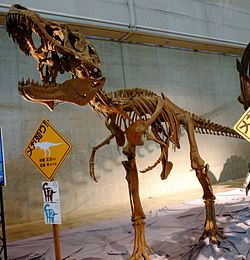Lythronax
|
Lythronax Temporal range: Late Cretaceous, 80 Ma |
|
|---|---|
 |
|
| Reconstructed skeleton | |
| Scientific classification | |
| Kingdom: | Animalia |
| Phylum: | Chordata |
| Class: | Reptilia |
| Clade: | Dinosauria |
| Order: | Saurischia |
| Suborder: | Theropoda |
| Family: | †Tyrannosauridae |
| Subfamily: | †Tyrannosaurinae |
| Genus: |
†Lythronax Loewen et al., 2013 |
| Type species | |
|
†Lythronax argestes Loewen et al., 2013 |
|
Lythronax is an extinct genus of tyrannosaurid theropod dinosaur that lived around 80.6 to 79.9 million years ago in what is now southern Utah, USA. The generic name is derived from the Greek words lythron meaning "gore" and anax meaning "king". Lythronax was a large sized, moderately-built, ground-dwelling, bipedal carnivore that could grow up to an estimated 8 m (26.2 ft) in length and weighed 2.5 tonnes (5,500 lb).
L. argestes is the oldest known tyrannosaurid, based on its stratigraphic position. It is known from a specimen thought to be from a single adult that consists of a mostly complete skull, both pubic bones, a tibia, fibula, and metatarsal II and IV from the left hindlimb, as well as an assortment of other bones. Its skull anatomy indicates that, like Tyrannosaurus, Lythronax had both eyes facing the front, giving it depth perception.
It has been estimated that Lythronax would have been about 7.3 m (24.0 ft) long, with a weight of around 2.5 tonnes (5,500 lb), based on comparisons to close relatives, and had a large skull filled with sharp teeth. The rostrum of its skull is comparatively short, since it makes up less than two thirds of the total skull length. The whole skull is very broad, and is only about 2.5 times as long as it is wide. Overall, the skull is morphologically most similar to that of Tyrannosaurus and Tarbosaurus. Its robust maxilla possessed a heterodont dentition, as its first five teeth are a lot larger than the other six. Like other tyrannosaurids, Lythronax has large, distally expanded pubic boot which is approximately 60% the length of the pubic bone. The postcranial morphology is similar to that of other tyrannosaurids.
...
Wikipedia
